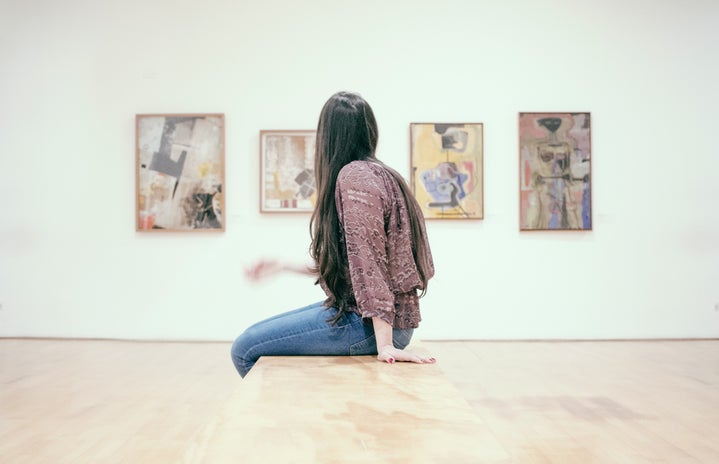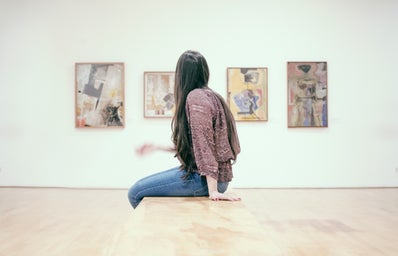In Sophie’s previous article, she debated the subject of art and the female body, and continues this again, by looking at artists who seek to spread a message of empowerment through their unique works.
Leiko Ikemura and Joe Hesketh are contemporary female artists, working with the concept of femininity, the female body and the patriarchy in the art. Whether you are familiar with Ikemura and Hesketh, or not at all, I hope you can understand their feminist messages – which are portrayed through their powerful art forms!
Joe Hesketh
They are an avant-garde artist whose works have been pushing against patriarchal boundaries and expectations placed on the female concerning beauty and the so-called ideal image that women should adhere to.
Rather than fit this mould, Hesketh aims to break these archaic traditions and ideologies which have been propagated through art history for so long. Her paintings show a glimmer of the grotesque and a sentiment of self-awareness and observation which is equally refreshing and haunting to its viewer.
Whenever I look at Hesketh’s work, I feel a sense of conflict, and confusion, towards the way I am supposed to react, on the one hand I stand with her political message of empowering the female, the reclamation of agency over her body, as well as the challenge her work poses to stereotypes and the ideal female image. All of which she subverts through her unconventional style of colour and textual blurring as well as creating females figures that are disproportionate and grotesque, and not considered a depiction of beauty to the male gaze.
However, I do find her artistic style challenging perhaps because her work is so raw and honest, possessing an immense sentiment of vulnerability in its depiction of the female. For me, this why I find her paintings conflicting because they show me a candid look into the female experience and the women that have rarely been portrayed before in art.
I think that her work reveals the darkness and confusion that is womanhood and the female experience in a patriarchal society, something not until this now has begun to be discussed.
Hesketh’s chaotic non-conformist paintings expose the ugliness of accepted expectations of the female in terms of image and beauty, something which needs to be explored more.
What I do love about her work is its multi-layered nature, in both in the material sense and metaphorical sense. Hesketh really seeks to provoke and stimulate her viewer into thinking about themselves and who they are and what it means to be a female in the twenty-first century.
Here is a link to one of Hesketh’s works, Snare.
Leiko Ikemura
Similar to Hesketh, Ikemura’s art is concerned with the female body and femininity, something which is explored in her first UK exhibition Usagi in Wonderland and more specifically the opening section Girls.
Perhaps like Hesketh the name Ikemura could be unfamiliar to some HerCampus readers, but I believe that her work contains incredibly important messages, and these should be recognised and shared with more people.
Whilst visiting the Sainsbury Art Centre in Norwich, I was introduced to Ikemura and the smaller section of her exhibition Girls (a collection of paintings she produced in the 1990) depicting the female figure and the difficulties of being female.
Within this collection Ikemura presents ethereal figures but also ghostly female forms which possess animal or plant-like characteristics, the style she uses to create these figures is remarkably non-conformist in its style as she portrays ambiguous figures which at time are hard to be identified as female in the conventional sense. Her females have little shaping around their bodies, no head or facial features.
I think that the ambivalence of her figures adds to the intrigue of her work and to the over-arching message she is trying to communicate to the viewer through her work.
To begin with when I first saw the Girls collection, I was confused, and it took me a few minutes to realise what Ikemura was trying to do.
Her work presented an alternative to the idealised version of female beauty that is celebrated in mainstream contemporary culture. Her female forms lack any conventional beauty standards which are praised and are expected that women possess, such as big eyes and lips, a curvaceous body etc. Ikemura however abstains from this misogynistic ideology and breaks away from the romanisation of the female form for the pleasure of the historic male-gaze.
What I gathered is that she desired to communicate about the female was that she is something that is other-worldly, something special and divine that should be celebrated. I think that this collection holds a great poignance as it’s a stance and a push at the boundaries of art and contemporary culture concerning the presentation and expectations of the female.
Follow the link to look at some of the painting from the Girls collections.
As it is evident, both Hesketh and Ikemura use their art as a vehicle to delve into the female experience and to unpick misogyny, additionally they both challenge the traditional, the “ideal”, and the fetishized image of the female in art, and in wider contemporary culture.
I think that their works are critical in progressing forward and reclaiming the art canon and the female space in art and the wider world, that has been for, so time occupied by their male-counterparts.


